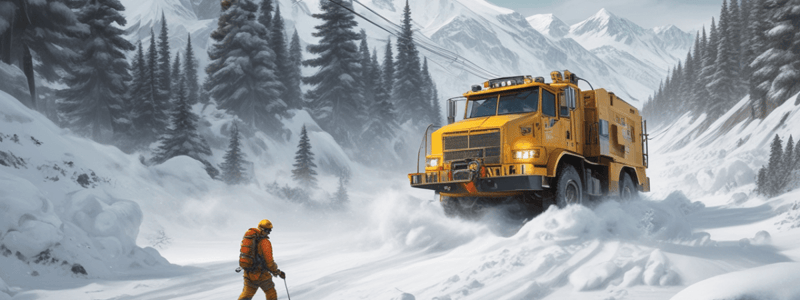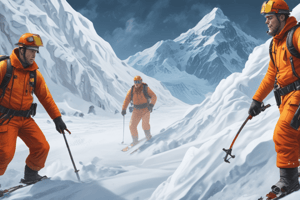Podcast
Questions and Answers
At what angle do avalanches rarely start?
At what angle do avalanches rarely start?
- More than 45° (correct)
- Exactly 45°
- Less than 30°
- Between 30° to 45°
What type of snow is most common in winter after storms?
What type of snow is most common in winter after storms?
- Wet new snow
- Heavy, wet, sun-heated snow
- Dry powder snow (correct)
- Wet snow
What is a characteristic of Loose Snow Avalanches?
What is a characteristic of Loose Snow Avalanches?
- They require snow with poor cohesion (correct)
- They are common in spring and summer
- They are massive and destructive
- They occur on north-facing slopes
What triggers Slab Avalanches?
What triggers Slab Avalanches?
What is an environmental factor that affects snow conditions?
What is an environmental factor that affects snow conditions?
What is a type of natural trigger for avalanches?
What is a type of natural trigger for avalanches?
What type of avalanches are common in spring and summer?
What type of avalanches are common in spring and summer?
What is a characteristic of Slab Avalanches?
What is a characteristic of Slab Avalanches?
What happens to persons exposed to household voltages?
What happens to persons exposed to household voltages?
What is a common cause of fires involving electrical equipment?
What is a common cause of fires involving electrical equipment?
What happens at very high voltages, such as from power lines?
What happens at very high voltages, such as from power lines?
What is a risk associated with electrical arcs?
What is a risk associated with electrical arcs?
What is the typical outcome of exposure to a low voltage current?
What is the typical outcome of exposure to a low voltage current?
What is the effect of the voltage on the body?
What is the effect of the voltage on the body?
What is the typical nature of electrical equipment in normal operating conditions?
What is the typical nature of electrical equipment in normal operating conditions?
What can happen if someone is exposed to an electrical source for a relatively long period?
What can happen if someone is exposed to an electrical source for a relatively long period?
How many provinces or territories are mentioned in the manual as areas where mine rescue teams operate?
How many provinces or territories are mentioned in the manual as areas where mine rescue teams operate?
What is the primary responsibility of mine rescuers in an emergency response?
What is the primary responsibility of mine rescuers in an emergency response?
What is the purpose of this manual?
What is the purpose of this manual?
What is the consequence of not performing mine rescue properly?
What is the consequence of not performing mine rescue properly?
What is the role of mine officials in the event of an emergency?
What is the role of mine officials in the event of an emergency?
What is the first step in becoming a mine rescue team member?
What is the first step in becoming a mine rescue team member?
What type of incident is mentioned in the manual as a potential response for mine rescue teams?
What type of incident is mentioned in the manual as a potential response for mine rescue teams?
What is the significance of mine rescue teams' training and practice?
What is the significance of mine rescue teams' training and practice?
What is the most dangerous type of avalanche?
What is the most dangerous type of avalanche?
Who plays a crucial role in the successful rescue of a person buried in an avalanche?
Who plays a crucial role in the successful rescue of a person buried in an avalanche?
When crossing an avalanche track, what should you do to prepare?
When crossing an avalanche track, what should you do to prepare?
What is the minimum required equipment for every avalanche rescuer?
What is the minimum required equipment for every avalanche rescuer?
When traveling on ice, what should be tested frequently in various locations?
When traveling on ice, what should be tested frequently in various locations?
What type of ice requires careful consideration when traveling on it?
What type of ice requires careful consideration when traveling on it?
What determines the strength of the ice when traveling on it?
What determines the strength of the ice when traveling on it?
Why should you assign a spotter at the top and bottom of the track when crossing an avalanche track?
Why should you assign a spotter at the top and bottom of the track when crossing an avalanche track?
What is the distinctive odour of hydrogen cyanide?
What is the distinctive odour of hydrogen cyanide?
At what temperature does hydrogen cyanide condense to a liquid?
At what temperature does hydrogen cyanide condense to a liquid?
What is the explosive range of hydrogen cyanide?
What is the explosive range of hydrogen cyanide?
How is hydrogen cyanide formed?
How is hydrogen cyanide formed?
Where may hydrogen cyanide occur?
Where may hydrogen cyanide occur?
What is the effect of hydrogen cyanide on the human body?
What is the effect of hydrogen cyanide on the human body?
What is the effect of a low concentration of hydrogen cyanide on humans?
What is the effect of a low concentration of hydrogen cyanide on humans?
What is the IDLH of hydrogen cyanide?
What is the IDLH of hydrogen cyanide?
Flashcards are hidden until you start studying
Study Notes
Mine Rescue
- Every mine must maintain a mine rescue team to ensure the safety of workers and property in B.C., Yukon, Northwest Territories, and Nunavut.
- Mine Rescue teams have responded to incidents and disasters in northern and western Canada for over a century.
Avalanche Response
- Avalanches can be triggered by natural events (new snow, temperature changes, sun, rain, thawing) or human activities (explosives, working on a slope, mobile equipment, recreational activities).
- Two types of avalanches:
- Loose Snow Avalanches: dry powder snow or wet snow, confined to surface layers, relatively small.
- Slab Avalanches: cohesive layers of snow, poorly bonded, breaks off along a fracture line, most dangerous.
Avalanche Safety
- To cross an avalanche track:
- Select the shortest possible route high on the slope or low in the run-out zone.
- Plan an escape route.
- Wear protective gear (mitts, hats, tight clothing).
- Assign a spotter at the top and bottom of the track and agree on a warning signal.
- Cross quickly, maintaining space between rescuers.
Avalanche Rescue Gear
- Minimum required equipment:
- Probe
- Avalanche transceiver (beacon)
- Shovel
Ice Travel
- Testing ice thickness is crucial for safe travel on frozen lakes and rivers.
- Table 3.1 indicates the weight that will be supported by varying thicknesses of clear blue lake-ice.
Electrical Emergencies
- Exposure to electricity can cause muscle spasms, electrical shock, and cardiac arrest.
- Voltage, current, and frequency affect the severity of electrical injuries.
- Special considerations for electrical emergencies include combustible materials and faulty electrical equipment.
Gas and Chemical Symbol: Hydrogen Cyanide (HCN)
- Properties: colorless, tasteless gas with a distinctive odor of bitter almonds.
- Formation: reaction of hydrochloric acid on cyanide compounds, such as potassium/sodium cyanide.
- Effects on humans: fast-acting and deadly poison, causes paralysis of the respiratory system and chemical asphyxiation.
- Physiological effects:
- 0-20 PPM: may detect odor, minor symptoms.
- 20-50 PPM: restlessness, increased respiratory rate, weakness, giddiness, difficulty breathing, heart palpitations, headache.
- >50 PPM: immediately dangerous to life and health (IDLH).
Studying That Suits You
Use AI to generate personalized quizzes and flashcards to suit your learning preferences.




